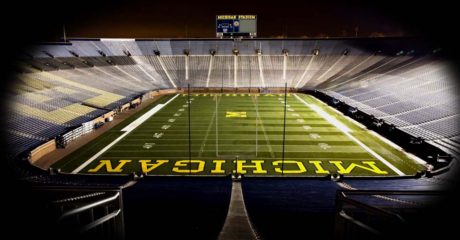Preview: Michigan vs. Maryland
 |
| Taylor Burton is Miss Maryland 2014 |
Rush Offense vs. Maryland Rush Defense
Despite a preference for running, Michigan is #78 nationally with 154 yards/game on the ground. They average 4.51 yards/carry, good enough for #57. The offensive line is improving, and head coach Brady Hoke claimed that the Northwestern game was their best performance of the season. The leading rusher is De’Veon Smith (487 yards, 5.1 yards/carry, 6 touchdowns), who finally overtook Derrick Green, a player that has been out since the Rutgers game. Smith looked good when he was decisive and hitting the hole hard against Northwestern, and he looked bad when he was trying to dance in the backfield. Drake Johnson (6.2 yards/carry, 2 touchdowns) has seen an uptick in his carries over the past couple weeks, but a fumble against Northwestern sent him into the doghouse. Maryland is #99 in rushing defense and gives up 198 yards/game, but their 4.32 yards/carry mark against them is #69. Junior strong safety/cornerback Sean Davis (6’1″, 190 lbs.) is their leading tackler with 94 stops, and senior inside linebacker Cole Farrand (6’3″, 245 lbs.) is second with 91. Sophomore outside linebacker Yannick Ngakoue (6’2″, 250 lbs.) leads the team with 12.5 tackles for loss, and undersized fifth year senior defensive tackle Andre Monroe (6’0″, 265 lbs.) is just behind him with 11. The only defensive lineman in the two-deep that is bigger than 275 lbs. is senior Darius Kilgo, the backup nose tackle in the Terrapins’ 3-4 look. This should be a manageable front to handle, talent-wise, and Michigan has some experience going against 3-4 defenses from the season opener against Appalachian State.
Advantage: Michigan
Hit the jump for the rest of the preview.
Pass Offense vs. Maryland Pass Defense
Michigan is #114 in passing yardage with 169 yards/game, and they’re 115th in passer efficiency. The passing offense is essentially broken. Quarterback Devin Gardner completes just over 61% of his passes but has thrown 13 interceptions with only 8 touchdowns. The leading receiver is Devin Funchess (50 catches, 595 yards, 4 touchdowns), who averages pedestrian 11.9 yards/catch. Amara Darboh (30 catches, 403 yards, 2 touchdowns) has turned into a favorite, and tight end Jake Butt (13 catches, 148 yards, 1 touchdown) is an underused threat. Michigan has allowed 19 sacks, which is 51st in the country. Maryland is tied for 28th in getting to the quarterback with 27 sacks altogether, led by Monroe (8 sacks) and Ngakoue (5.5). They also are 33rd in passer efficiency rating defense. Even so, the Terps are 86th in passing yardage allowed (239 yards/game). Sophomore cornerback William Likely has 5 interceptions, which he has returned for 141 yards and 2 touchdowns (against Syracuse and Iowa). Since I don’t do a separate special teams section, I’ll mention here that Likely averages over 32 yards/return on kickoffs and almost 11 yards/return on punts, including a score. Likely is dangerous, and Michigan is bad in this phase.
Advantage: Maryland
Rush Defense vs. Maryland Rush Offense
Michigan is one of four Big Ten teams in the top eight nationally in rushing defense, behind Penn State (#1) and Wisconsin (#5), and ahead of Michigan State (#8). The Wolverines are #7 and allow 103 yards/game. The last opponent, Northwestern, ended up with -9 total rushing yards. Jake Ryan (90 tackles, 13 tackles for loss) has grown more comfortable in his middle linebacker position, and weakside linebacker Joe Bolden (79 tackles) has matured somewhat, too. The most improved player this year might be nose tackle Ryan Glasgow, who has 20 tackles and 3 tackles for loss while clogging the middle. Unfortunately, Michigan lost their best defensive lineman when senior Frank Clark was kicked off the team earlier this week for a domestic violence incident. Junior Mario Ojemudia (24 tackles, 7 tackles for loss) slides into Clark’s vacated weakside end spot. Maryland is #113 in rushing (114 yards/game) and led by sixth year senior quarterback C.J. Brown (6’3″, 210 lbs.), who has 375 yards, 5 touchdowns, and a 3.2 yards/carry average, which isn’t bad for a quarterback who takes some sacks. Neither of Maryland’s backs is very effective, with redshirt sophomore Wes Brown (6’0″, 210 lbs.) averaging 3.4 yards and redshirt junior Brandon Ross (5’10”, 205 lbs.) averaging 4.1. Fifth year senior center Sal Conaboy (6’3″, 295 lbs.) is the best lineman, and the rest are not particularly big, experienced, or accomplished.
Advantage: Michigan
Pass Defense vs. Maryland Pass Offense
Michigan is #25 against the pass (198 yards/game) and #68 in passer efficiency rating defense. Clark was the team’s best pass rusher despite being second on the team in sacks behind defensive end Brennen Beyer (5.5 sacks), a guy who lacks some athleticism but wins battles by being relentless. Ojemudia has 3.5 sacks in a backup role, so he may provide a bit of a spark at some points. Defensive tackle Willie Henry can get after the quarterback, too, but he has been playing less lately after an injury he suffered against Rutgers. On the back end, Michigan has just 5 interceptions on the season, which is tied for 111th. Corner Jourdan Lewis is the only defensive back to notch an interception, and fellow corners Blake Countess and Delonte Hollowell have been picked on. Hollowell, in particular, will be targeted if he enters the game as a backup or dime corner. Meanwhile, Maryland is #66 in passing (230 yards/game) and #90 in passer efficiency. Brown completes fewer than 53% of his passes, averages just 6.2 yards/attempt, and has a subpar 11-to-9 touchdown to interception ratio. On top of his issues, they will be missing star receiver Stefon Diggs (lacerated kidney) and backup Juwann Winfree (suspension). Senior Deon Long (6’1″, 180 lbs.) will be the top target and has 38 catches for 450 yards and 1 touchdown. Redshirt junior Marcus Leak (6’0″, 210 lbs.) averages 15.3 yards/catch and has 3 touchdowns, but he has failed to record a catch in three of the last four games and has just 2 catches for 23 yards in that entire span. Ross is a threat out of the backfield, but overall, this should not be an intimidating receiving corps. Maryland has allowed 27 sacks, which is tied for #103 in the country. Long might make some plays, but this should not be a phase that the Terrapins win.
Advantage: Michigan
Roster Notes
- Players recruited by Michigan include RB Wes Brown, QB Shane Cockerille, WR Stefon Diggs, LB Clarence Murphy, LB Yannick Ngakoue, OT Damian Prince, WR Will Ulmer, WR Juwann Winfree
- Wide receivers coach Keenan McCardell was a two-time Pro Bowl receiver, most notably for the Jacksonville Jaguars and Tampa Bay Buccaneers
Last Time They Played . . .
- Michigan is 3-0 historically against Maryland, including the last time they met, which was 1990
- Elvis Grbac went 15/25 for 2 touchdowns and 1 interception
- Jon Vaughn had 22 carries for 89 yards and 2 touchdowns
- Desmond Howard caught 3 passes for 59 yards and 1 touchdown
- Neil Simpson led the team with 10 tackles
- Vada Murray, Martin Davis, and Lance Dottin each had 1 interception
- Michigan won by a score of 45-17
Predictions
- Michigan holds Maryland under 100 yards rushing
- De’Veon Smith goes for 120 yards and 2 touchdowns
- Michigan’s defense actually defends the pass for a change
- Michigan 23, Maryland 17




